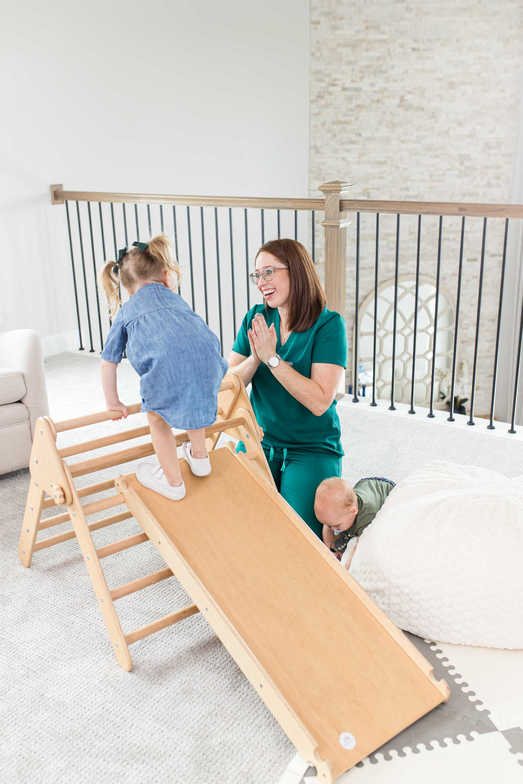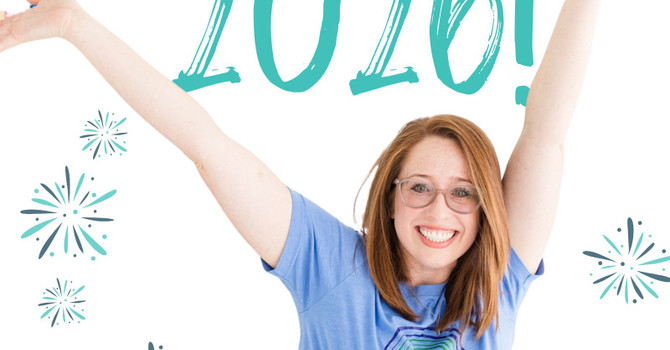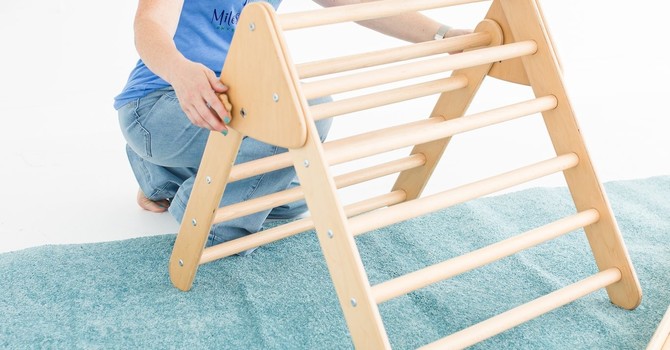
My goal with these checklists is to create a resource for parents, a resource that provides both the age-appropriate milestones AND purposeful play ideas on how to help your little one stay on track. There is so much information out there, sometimes information overload, and having this in one place I hope it makes your parenthood journey a little easier.
If you are reading this you probably have a toddler running wild and free! This time is fun, yet can also be terrifying because nothing is faster than a toddler who shouldn’t be climbing, jumping, or running where they aren’t supposed to be! Be sure you have toddler proofed the house in a way you feel it is safe enough for your little human to move throughout the house, especially securing the stairs to limit falls. For us we used baby gates, gates at the top and bottom of the stairs and at the bedroom door (mostly to keep the dogs out of his room), outlet covers, and cabinet locks in certain areas.
A lot is happening from 18-24 months! This is the time when your child embraces their individuality and independence, walking at home and in the community. They are beginning to explore and develop further balance, coordination, and body awareness, preparing them for those higher-level gross motor skills. As stated in my previous blog this is a FUN age, yet expect to see a lot of bumps and bruises as those gross motor skills move toward mastery.
Playing with purpose during this age (and most ages) is truly about toy placement and environment set up; I’ll break it down with a few essential activities for 18-24 months below:
- Walking: By this age your little one is a relatively proficient walker on level ground. As they develop improved balance and coordination with walking try an obstacle course! Walking over couch cushions, stepping over broom sticks, walking forward, backward, and sideways to get around objects, and even walking on different surfaces (hardwood floors to/from carpet, sidewalks to/from grass). Practicing walking on different surfaces will prepare your little one for navigating playgrounds, school, and the community.
- Running: Running will begin to emerge, initially as fast walking and eventually into a mature running pattern but not typically until 4-5 years of age. So, don’t worry if running looks uncoordinated at this time – because it should! Often little ones improve their speed and coordination with practice – I like to play freeze tag, race from one room to the other, or on the playground with their peers.
- Jumping: Jumping is a skill that fully emerges around 2 years of age. During this time expect to see your little one bouncing in place or even jumping down from small objects. Before your little one jumps, they must have sufficient strength in their legs and calves. You can help your little one by playing in a deep squat, practicing sit to standing from a low surface, or practicing reaching overhead to encourage tiptoes. Bubbles are a GREAT way to get a little one to squat and go up on tiptoes. You can also use suction cup toys and place them just out of reach on the window or refrigerator to encourage your little one to go up on their toes. To practice jumping, start on a couch cushion, mini trampoline or mattress and progress toward jumping down from objects, the goal is for your little one to be able to jump down from a step or couch AND remain in standing – this shows us they have good strength in their legs and core.
- Climbing: Oh man, the climbing can be intense during this age! Climbing onto couches, dining room chairs, tables, counter tops, up a flight of stairs, you name it! I highly recommend showing your child how to climb down from whatever surface they find themselves on. The best way is backward and, on their belly, feet first. Climbing has so many benefits – it’s great for total body strengthening, coordination, and facilitates healthy risk-taking opportunities. A pikler triangle, couch cushions, chairs, playground, and stairs are all excellent climbing apparatuses.
- Ball Skills: By this age your little human has the balance and coordination to kick a ball without tripping over it (will this still happen, probably and that’s ok). Same goes for throwing, its likely your child can throw overhand and underhand to some extent. Practice with bean bags or the paddles with Velcro so you’re not chasing a ball ALL OVER THE PLACE. Balloons and bubbles are another way to develop improved hand-eye coordination. Use a balloon and play “keepity uppity” with hands, a tennis racket, or even an unused fly swatter. As for bubbles, you can have your child pop the bubbles with their hands by clapping or using the same unused fly swatter. Pro tip: encourage them to hold the tennis racket, paddles, or fly swatter with both hands that way you’re also encouraging improved bilateral coordination, or coordination involving both the right and left sides – this also works the trunk muscles!
- Balance: During the 18-24 month range, kiddos are experimenting with balance. You may see your little one walking backward, sideways, or attempting to walk on a line. When you see these activities, encourage them, it will only help them in the long run. At home you can use painters' tape on the floor, a balance beam (this one is great too!), or stepping stones (these are great too!) to create a line, practice walking forward, backward, and sideways on it. And don’t forget the curbs when out in the community, hold your little one's hands and encourage them to walk on the curbs like a balance beam – you can literally do this anywhere! And while you're at it, encourage jumping off the end too! Ta-Da! You just tackled TWO purposeful play activities on your way to the car. Another fun balance activity at this age is using a balance board!
- Tiptoes: I mentioned tiptoes early in the jumping section. However, standing and balancing while standing on tiptoes is a completely different skill. It required endurance and stability at the ankles and trunk. You can practice going up on tiptoes for balance the same way you would to encourage improved calf strength for jumping - place suction cup toys on windows, use painters tape to stick toys to the wall, or any toy on the counter tops just out of reach to encourage your little one to go up on their toes. Bubbles are another great activity, blow the bubbles and catch one with the wand, then hold it just about their finger tips and watch them go up on their toes. It’s so much fun!
- Ride On Toy: And lastly, ride on toys! This is the beginning of your bike and scooter adventure. Find a ride on toy that allows your child’s feet to be flat on the floor, this way they can easily climb on and propel themselves. There are SO many options and so many price points. We enjoyed the Tiny Tot Tricycle and Balance Bike from Kinderfeets. It grew with my son and later transitioned to a balance bike when he was ready, although he used the tricycle set up from 12 months to 2+ years old because he had a need for speed!
As with all phases, this phase is an exciting one and it should be full of adventure! However, remember development is a continuum and all kids move at their own pace. Not all follow the developmental progression and that is OK! So, hang in there! At this age, if you notice your child is consistently walking on their toes more than 80% of the time, not showing interest in jumping or ball skills or continues to have frequent falls consider a pediatric physical therapy evaluation from your local therapist and don't hesitate to reach out to Milestones At Play, you can book a free discovery phone call! As a mom and a pediatric physical therapist, I am here to help! It is my goal to set kiddos and parents up for gross motor success. Stay tuned as I publish more blog posts with checklists from birth - 5 years of age!
And if you made it this far, thank you! And check out and follow, like, comment, etc. our social media accounts. I appreciate it!
Instagram: @milestonesatplay
Facebook: Milestones At Play
TikTok: @milestonesatplay


